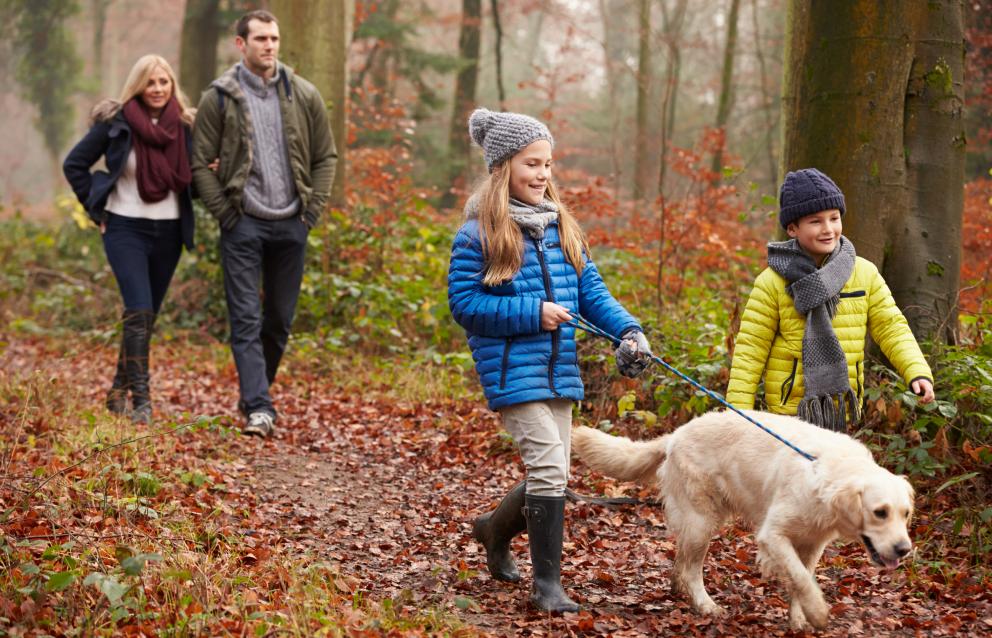You are here
Canine Fitness

Depending on your pet’s breed, as well as their personality, you may have noticed that your pet is much more content when exercise is a part of their regular routine. Dogs, especially puppies, can get into trouble if they aren’t given something to do. Natural behaviours such as chewing, digging, scratching, and play biting can become excessive and therefore problematic.
An active routine is healthy for humans as well! We recommend both you and your pet check with your doctor and veterinarian to ensure your exercise is safe and discuss which types of activities are best for you and your pet.
Older pets also benefit from regular exercise. Low impact exercise such as walking and swimming are the best choices. Even with arthritic pets, exercise helps increase flexibility, strengthens muscles around the joints, keeps bowel function regular, and helps control weight.
Here are some ideas to integrate exercise into your schedule for you and your pet.
- Walking – this form of exercise is safe for everyone. Just start gradually at 10 minutes/day and work up from there! Keep a brisk enough pace to elevate your heart rate.
- Jogging – people actually adapt better to jogging or long distance running compared to dogs. If you consider what your breed of dog was bred to do, you will see that most dogs are bred for short bursts of running interspersed with stops or a slower pace such as dogs herding sheep or a greyhound chasing a rabbit. Start small to gradually gain endurance. Watch your dog for signs of tiring or heat exhaustion (panting excessively, refusal to follow you, weakness). Short-faced breeds such as pugs and bulldogs are especially vulnerable. If either of you are sore or stiff the next day, decrease the intensity.
- Do not take your puppy jogging. Wait until they are full grown and then gradually build up to 30-minute jogs.
- Deep chested dogs, such as Irish Wolfhounds, Great Danes, and Standard Poodles, should avoid exercise right after a meal to decrease the risk of Gastric Dilation/Torsion.
- Long walks on rough surfaces can damage a dog's paws. Start slowly. If you work your way up to longer walks, most dogs will develop thicker pads on their feet and not have problems. On hot days, pavement and sand can get very hot. In winter, check paws for ice build-up. Consider buying a set of dog booties to protect the paws.
- Frisbee or fetch – this is natural fun for dogs. Cautions include:
- As dogs get older, jumping up to catch a Frisbee is hard on their joints and can lead to intervertebral disc disease or anterior cruciate ligament damage.
- When playing fetch, avoid balls that are small enough to cause choking. Also avoid sticks that can have sharp ends that could puncture the mouth or throat.
- Dog park – just let them have fun, but there are some dog etiquette guidelines:
- Dogs don’t like groups or individual dogs rushing up. Keep your dog under control or on a leash to prevent rushing to meet other dogs.
- If your dog has a tendency to steal balls, the ‘come’ command becomes very important. If your dog has selective hearing when it comes to balls or toys you may have to keep him/her on a leash.
- Overly rough play can quickly deteriorate into a fight. Call your dog over to you and distract him with another activity if things are getting too rough.
- Train your dog to sit politely when he greets other people. This prevents jumping up.
- If your dog is fearful, new to socializing with other dogs or recovering from a recent surgery, consider putting a yellow ribbon on his/her collar. Check out Yellow Dog Project for more information.
- Daycare for Dogs – Taking your dog to a daycare even once or twice per week can help in keeping your dog content. Your dog will play with other dogs and socialize throughout the day. When selecting a day care, be sure to visit the daycare once or twice to view how the staff interacts with the pets under their care, and how clean the facility is. Also a facility with a strict vaccination and deworming policy will be healthiest for your pet.
- Hiking – When hiking in isolated areas be sure to have a first aid kit that can work for both you and your dog. Ticks have become more prevalent in Alberta, so make sure you cover up and apply an insect repellent containing DEET and protect your dog with tick prevention and a Lyme vaccine. After hiking, check your body for ticks and do the same for your dog.
- Flyball – A fun activity that many breeds of dogs enjoy. Humans get to cheer on the sidelines. There are flyball clubs in several Alberta locations.
- Agility – This activity is great exercise for both your dog and you. Agility training and competition is good for your dog’s physical and mental health. There are several agility clubs in Alberta.
- Swimming – As with humans, swimming is a great low-impact exercise that is easy on the joints. Swimming does not come naturally to all dogs. Use toys for encouragement. Start gradually and supervise closely. Here are some safety tips.
Additional resources:
Hill's Pet Exercise and Fitness Tips
Edmonton Journal article with local personal trainer, Lorraine Glass, on exercising with your dog
American SPCA, Exercise for Dogs
Dog Agility Equipment for Backyard Training and Just Plain Fun
